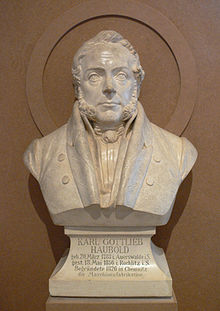Carl Gottlieb Haubold

Carl Gottlieb Haubold (born March 20, 1783 in Auerswalde , † May 18, 1856 in Rochlitz ) was a German entrepreneur. He is considered the father of mechanical engineering in Chemnitz and the founder of the Hauboldwerke (later ERMAFA ) named after him .
Life
Haubold came from a farming family and grew up in poor conditions in Auerswalde. At the age of 14 he began training with a master carpenter in Chemnitz. From 1807 he worked in the machine spinning mills of the companies " Gebrüder Bernhard " in Harthau and at " Wöhler & Lange " in Furth . The spinning machines existed at that time still largely made of wood. Haubold acquired knowledge of the technical functioning of spinning machines in the company's repair workshops and in the course of these positions rose to become a master carpenter.
In 1810 Haubold married Christiane Dorothea König. A year later he set up a small machine shop for the production of mechanical spinning machines in Brüdergasse. A horse peg served as a drive . The young company also had a small spinning mill. In 1815, Haubold also began manufacturing cotton beating machines .
With the dowry of his wife, a government loan and the financial support of his cousin Carl Gottfried Haubold (1792–1862), who later became known as a mechanical engineer, Carl Gottlieb Haubold leased the Wöhlersche spinning mill in Furth in 1822 , the oldest mechanical cotton mill in Saxony. For the first time, water power was also available as a drive. At that time his company had 30 employees who concentrated on mechanical engineering and spinning. In 1826 he bought the entire company and ran a weaving mill in addition to the spinning mill. In 1828 the factory employed 100 workers in the mechanical engineering department alone. 72 adults and 28 children worked in the spinning mill in 1831. In 1830 he made study trips to several European countries with financial support from the Saxon government. The company's workforce increased to 300 factory workers and 200 homeworkers. In 1832, Haubold opened up the paper press market by building a shredder and a semi-finished press for rag and paper production.
Haubold's mechanical engineering department quickly became known beyond the borders of Saxony and Germany. Men like Richard Hartmann and Johann Zimmermann , both great entrepreneurs from Chemnitz, began their careers at Haubold. Business boomed in the 1830s, it was the time of the Industrial Revolution in Germany. Haubolds Maschinenfabrikation founded Chemnitz mechanical engineering.
The prosperous business enabled him to acquire the Wöhler spinning mill for 26,000 thalers in 1834, as well as extensive expansion and reconstruction of the factory. However, he had to sell the company, which had 500 workers, to the Sächsische Maschinenbau-Compagnie in 1836 because of outstanding loan payments . Haubold bought the same for 82,000 thalers and took over the technical management. In 1838 the company got a 25 HP steam turbine in addition to the existing water wheel - the first steam turbine in Chemnitz. As a result, in addition to textile machines, the company also manufactured paper machines and lathes, water wheels, hydraulic presses and finally steam engines and turbines. In 1839 the Saxon mechanical engineering company under the direction of Carl August Rabenstein from the Royal Trade School in Chemnitz built the second locomotive in Saxony, the Pegasus . In the same year, Haubold left the company and again founded his own worsted spinning mill , which he sold in 1849. The Sächsische Maschinenbau-Compagnie went bankrupt in 1852 and was liquidated.
Carl Gottlieb Haubold died in Rochlitz on May 18, 1856.
Merit
Carl Gottlieb Haubold is considered the father and founder of Chemnitz mechanical engineering. He was the first mechanical engineer in Chemnitz to develop his production facility from a factory to a factory . His company was also important for recruiting young entrepreneurs. With Richard Hartmann, Johann Zimmermann and Konstantin Pfaff, some of the later most important Saxon mechanical engineers learned their trade from Carl Gottlieb Haubold.
literature
- Ernst Barth: A pioneer of the Chemnitz mechanical engineering industry: Carl Gottlieb Haubold. in: Sächsische Heimatblätter issue 1/1984, p. 30, ISSN 0486-8234
- Herbert Pönicke: Haubold, Carl Gottlieb. In: New German Biography (NDB). Volume 8, Duncker & Humblot, Berlin 1969, ISBN 3-428-00189-3 , p. 71 f. ( Digitized version ).
- Wolfgang Uhlmann : Carl Gottlieb Haubold - father of mechanical engineering in Chemnitz. in: Erzgebirge Homeland Papers . Issue 2/1993. Pp. 26-27.
- Early documents and newspaper articles on CG Haubold AG in the 20th century press kit of the ZBW - Leibniz Information Center for Economics .
Web links
- Short biography
- Schönherr News - The Magazine , Issue 3 (PDF; 3.2 MB) at Schönherrfabrik.de
- Schönherr News - The Magazine , Issue 4 (PDF; 2.3 MB) at Schönherrfabrik.de
| personal data | |
|---|---|
| SURNAME | Haubold, Carl Gottlieb |
| BRIEF DESCRIPTION | German entrepreneur |
| DATE OF BIRTH | March 20, 1783 |
| PLACE OF BIRTH | Auerswalde |
| DATE OF DEATH | May 18, 1856 |
| Place of death | Rochlitz |